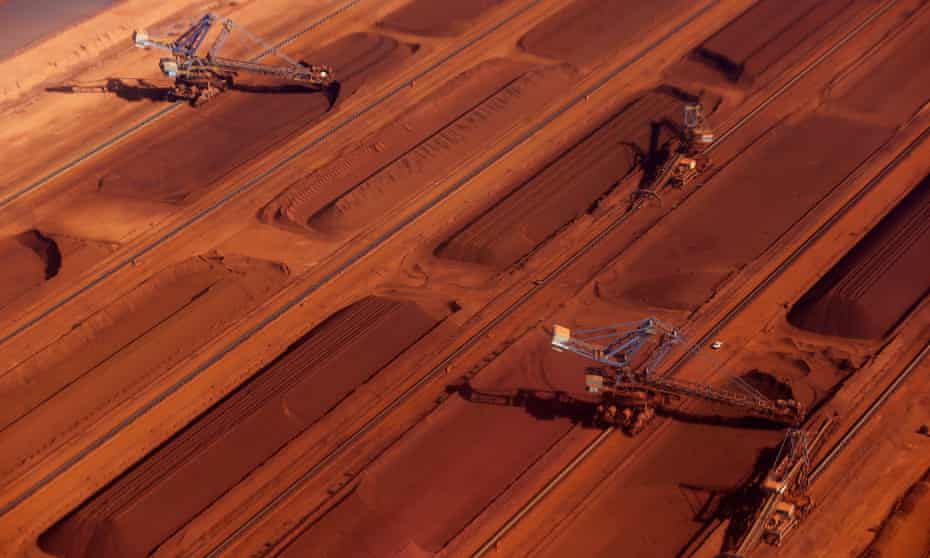Extract from The Guardian
Cheap renewable energy could see industry upgrade iron ore production and lure steelmaking onshore, expert says.

Australia’s relatively low-quality iron ore could be less attractive to steelmakers using green hydrogen, a report has found.
The conclusion is contained in the consultancy’s “Decarbonising Steel: A Net-Zero Pathway” report released on Tuesday. It identified different ways one of the biggest greenhouse-gas emitting industries could wean itself off fossil fuels.
The report estimated the transition to net zero emissions would need as much as $US278b ($A388b) in extra investment, a shift to greater use of recycled steel and also a range of carbon prices.
The report noted the move to electric arc furnaces, preferably powered by renewable energy, would typically require high-grade iron ore pellets as feedstock.
“There is a limited amount of high-grade ore currently being produced, mostly in the Americas, Europe and the Middle East, though there are good quality reserves in South Africa, India, Russia and Brazil,” the report said.
“Lower-quality ore producers in Australia will need to further refine their product in order to make it suitable for hydrogen [electric arc furnaces], potentially raising production costs,” it said.
“This issue could impede the uptake of hydrogen direct reduction technology, or conversely it could result in iron ore production and possibly green steelmaking capacity moving closer to higher-grade ore producers.”
Iron ore is Australia’s largest single export, worth about $150b in the year to June. With falling ore prices, the commodity is forecast to bring in about $113b by 2022-23, the government said earlier this year.
Accounting for about 7% of global emissions, the steel industry will be at the forefront of efforts to cut carbon pollution if dangerous climate change is to be averted. Hydrogen, particularly made from renewable energy, offers a potential substitute for the metallurgical coal burned in the steel-making process if production of the fuel can be scaled up and prices fall.
Academics such as associate professor at Australian National University John Pye have also identified the threat to Australia’s predicted mineral wealth if green steel developments end up favouring ores other than those found in Western Australia’s Pilbara region.
“It’s so important to Australia’s balance sheet,” Pye said, adding “the jury’s out as to how competitive we can be in a decarbonised steel sector.”

Pye said a process known as beneficiation – which removes impurities in the ore -would be needed to raise the quality of Australia’s minerals to that of Brazil’s or other rivals’, but that would add to costs and cut miners’ profits.
Similarly, green hydrogen processes may favour magnetite ores over the hematite ores that dominate in the Pilbara, Pye said.
The region, though, is not without magnetite. Fortescue Metals is currently building a magnetite operation in the Pilbara called Iron Bridge, with first production scheduled for the end of 2022. It would be the only one of the big three with a magnetite operation when it comes online.
Global head of industry decarbonisation at BloombergNEF, Kobad Bhavnagri, said the shift to green steel “could cause both great disruption, and great opportunity, for Australia’s iron ore miners”.
“Numerous studies show that green hydrogen is emerging as both the cheapest and most practical way to make green steel,” Bhavnagri said. “But this technology change poses a challenge for Australia. Not only will it virtually wipe out metallurgical coal exports, but iron ore exports could take a hit too, if miners don’t adapt.”
Bhagnagri said it wasn’t inevitable Australian iron ore producers would lose out since the country’s abundance of low-cost renewable energy gives the country an opening to upgrade iron-ore production onshore and also lure more of the steelmaking to Australia.
“Australian companies will need to take the lead to shape the future of the industry in their favour, or risk it evolving in a way that deals them out,” he said.
The Guardian Australia approached several iron ore producers and steelmakers for comment.
No comments:
Post a Comment